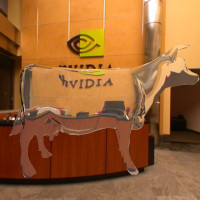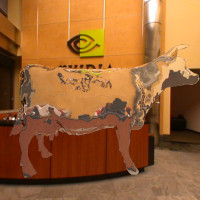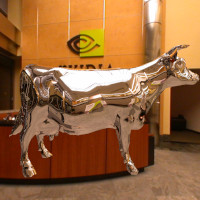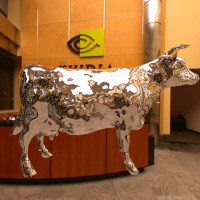

This page was last updated: January 3, 2025

| 
| 
| 
|
| Refraction | Refraction with Noise | Reflection | Reflection with Noise |
Using a GLIB file (for glman) or using the GLSL API, use the following uniform variables:
| Parameter | What It Does | Does it have to be varied? |
|---|---|---|
| uMix | Blend of reflection and refraction | Yes |
| uNoiseAmp | Noise Amplitude | Yes |
| uNoiseFreq | Noise Frequency | Yes |
| uEta | Index of refraction | No |
| uWhiteMix | Mixing of WHITE with the refraction | No |
##OpenGL GLIB
Perspective 70
LookAt 0 0 3 0 0 0 0 1 0
Vertex texture.vert
Fragment texture.frag
Program Texture TexUnit 6
Texture2D 6 nvposx.bmp
QuadYZ 5. 5. 10 10
Texture2D 6 nvnegx.bmp
QuadYZ -5. 5. 10 10
Texture2D 6 nvposy.bmp
QuadXZ 5. 5. 10 10
Texture2D 6 nvnegy.bmp
QuadXZ -5. 5. 10 10
Texture2D 6 nvposz.bmp
QuadXY 5. 5. 10 10
Texture2D 6 nvnegz.bmp
QuadXY -5. 5. 10 10
CubeMap 6 nvposx.bmp nvnegx.bmp nvposy.bmp nvnegy.bmp nvposz.bmp nvnegz.bmp
CubeMap 7 nvposx.bmp nvnegx.bmp nvposy.bmp nvnegy.bmp nvposz.bmp nvnegz.bmp
Vertex cube.vert
Fragment cube.frag
Program Cube \
uReflectUnit 6 \
uRefractUnit 7 \
uMix <0. 0. 1.> \
uNoiseAmp <0. 0. 5.> \
uNoiseFreq <0.0 0.1 0.5> \
uWhiteMix 0.2 \
uEta 1.4
Scale 0.4
Obj cow.obj
float Eta;
float Mix;
float NoiseAmp;
float NoiseFreq;
GLSLProgram Pattern;
GLuint CubeName;
char * FaceFiles[6] =
{
"kec.posx.bmp",
"kec.negx.bmp",
"kec.posy.bmp",
"kec.negy.bmp",
"kec.posz.bmp",
"kec.negz.bmp"
};
. . .
void
InitGraphics( )
{
// open the window . . .
// setup the callbacks . . .
// initialize glew . . .
// create and compile the shader . . .
// set the uniform variables that don't need to vary . . .
glGenTextures( 1, &CubeName );
glBindTexture( GL_TEXTURE_CUBE_MAP, CubeName );
glTexParameterf( GL_TEXTURE_CUBE_MAP, GL_TEXTURE_WRAP_S, GL_REPEAT );
glTexParameterf( GL_TEXTURE_CUBE_MAP, GL_TEXTURE_WRAP_T, GL_REPEAT );
glTexParameterf( GL_TEXTURE_CUBE_MAP, GL_TEXTURE_WRAP_R, GL_REPEAT );
glTexParameterf( GL_TEXTURE_CUBE_MAP, GL_TEXTURE_MAG_FILTER, GL_LINEAR );
glTexParameterf( GL_TEXTURE_CUBE_MAP, GL_TEXTURE_MIN_FILTER, GL_LINEAR );
for( int file = 0; file < 6; file++ )
{
int nums, numt;
unsigned char * texture2d = BmpToTexture( FaceFiles[file], &nums, &numt );
if( texture2d == NULL )
fprintf( stderr, "Could not open BMP 2D texture '%s'", FaceFiles[file] );
else
fprintf( stderr, "BMP 2D texture '%s' read -- nums = %d, numt = %d\n", FaceFiles[file], nums, numt );
glTexImage2D( GL_TEXTURE_CUBE_MAP_POSITIVE_X + file, 0, 3, nums, numt, 0,
GL_RGB, GL_UNSIGNED_BYTE, texture2d );
delete [ ] texture2d;
}
. . .
void
Display( )
{
. . .
int ReflectUnit = 5;
int RefractUnit = 6;
Pattern.Use( );
glActiveTexture( GL_TEXTURE0 + ReflectUnit );
glBindTexture( GL_TEXTURE_CUBE_MAP, CubeName );
glActiveTexture( GL_TEXTURE0 + RefractUnit );
glBindTexture( GL_TEXTURE_CUBE_MAP, CubeName );
Pattern.SetUniformVariable( "uReflectUnit", ReflectUnit );
Pattern.SetUniformVariable( "uRefractUnit", RefractUnit );
Pattern.SetUniformVariable( "uMix", Mix );
Pattern.SetUniformVariable( "uEta", Eta )
glCallList( ObjectList );
Pattern.UnUse;
}
#version 330 compatibility
out vec3 vNormal;
out vec3 vEyeDir;
out vec3 vMC;
void
main( )
{
vMC = gl_Vertex.xyz;
vec3 ECposition = ( gl_ModelViewMatrix * gl_Vertex ).xyz;
vEyeDir = ECposition.xyz - vec3( 0., 0., 0. ) ;
// vector from the eye position to the point
vNormal = normalize( gl_Normal );
gl_Position = gl_ModelViewProjectionMatrix * gl_Vertex;
}
#version 330 compatibility
uniform sampler3D Noise3;
uniform float uNoiseAmp;
uniform float uNoiseFreq;
uniform float uEta;
uniform float uMix;
uniform float uWhiteMix;
uniform samplerCube uReflectUnit;
uniform samplerCube uRefractUnit;
in vec3 vNormal;
in vec3 vEyeDir;
in vec3 vMC;
const vec3 WHITE = vec3( 1.,1.,1. );
vec3
PerturbNormal3( float angx, float angy, float angz, vec3 n )
{
float cx = cos( angx );
float sx = sin( angx );
float cy = cos( angy );
float sy = sin( angy );
float cz = cos( angz );
float sz = sin( angz );
// rotate about x:
float yp = n.y*cx - n.z*sx; // y'
n.z = n.y*sx + n.z*cx; // z'
n.y = yp;
// n.x = n.x;
// rotate about y:
float xp = n.x*cy + n.z*sy; // x'
n.z = -n.x*sy + n.z*cy; // z'
n.x = xp;
// n.y = n.y;
// rotate about z:
xp = n.x*cz - n.y*sz; // x'
n.y = n.x*sz + n.y*cz; // y'
n.x = xp;
// n.z = n.z;
return normalize( n );
}
void
main( )
{
vec3 Normal = ????? // remember to unitize this
vec3 Eye = ????? // remember to unitize this
vec4 nvx = texture( Noise3, uNoiseFreq*vMC );
vec4 nvy = texture( Noise3, uNoiseFreq*vec3(vMC.xy,vMC.z+0.33) );
vec4 nvz = texture( Noise3, uNoiseFreq*vec3(vMC.xy,vMC.z+0.67) );
float angx = nvx.r + nvx.g + nvx.b + nvx.a; // 1. -> 3.
angx = angx - 2.; // -1. -> 1.
angx *= uNoiseAmp;
float angy = nvy.r + nvy.g + nvy.b + nvy.a; // 1. -> 3.
angy = angy - 2.; // -1. -> 1.
angy *= uNoiseAmp;
float angz = nvz.r + nvz.g + nvz.b + nvz.a; // 1. -> 3.
angz = angz - 2.; // -1. -> 1.
angz *= uNoiseAmp;
Normal = PerturbNormal3( angx, angy, angz, Normal );
Normal = normalize( gl_NormalMatrix * Normal );
vec3 reflectVector = ?????
vec3 reflectColor = ?????.rgb
vec3 refractVector = ?????
vec3 refractColor;
if( all( equal( refractVector, vec3(0.,0.,0.) ) ) )
{
refractColor = reflectColor;
}
else
{
refractColor = texture( uRefractUnit, refractVector ).rgb;
refractColor = mix( refractColor, WHITE, uWhiteMix );
}
gl_FragColor = mix( ?????, ?????, uMix );
}
These are only used for wall decorations. They don't actually participate in the cube mapping, but the cube mapping looks weird without them.
texture.vert:
#version 330 compatibility
out vec2 vST;
void
main( )
{
vST = gl_MultiTexCoord0.st;
gl_Position = gl_ModelViewProjectionMatrix * gl_Vertex;
}
texture.frag:
#version 330 compatibility
uniform sampler2D TexUnit;
in vec2 vST;
void main( )
{
vec3 newcolor = texture( TexUnit, vST ).rgb;
gl_FragColor = vec4( newcolor, 1. );
}
Use Canvas to turn in your:
Want to use the Nvidia Lobby in a cube map?
Here are the files:
nvposx.bmp
nvnegx.bmp
nvposy.bmp
nvnegy.bmp
nvposz.bmp
nvnegz.bmp
Want to use the Kelley Engineering Center Atrium in a cube map?
Here are the files:
kec.posx.bmp
kec.negx.bmp
kec.posy.bmp
kec.negy.bmp
kec.posz.bmp
kec.negz.bmp
Here is a good source of other cube maps.
| Feature | Points |
|---|---|
| Refracts correctly | 30 |
| Reflects correctly | 30 |
| Bump-maps correctly | 40 |
| Potential Total | 100 |